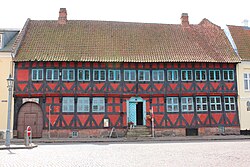History
Established around 1170, the moated castle was originally square-shaped with corner towers connected by a curtain wall. A residential building (palatium) was constructed next to the west wall in the mid-13th century and a strong defensive tower was built on the east wall. It was here that King Eric V signed Denmark's first constitution in 1282. [2] Until 1413, the palatium was the main venue for the Danehof or medieval parliament.
King Christian III, [3] who frequently stayed in the building, created a new banqueting hall and a tower in the 1540s. Under King Christian IV, [4] additional work was performed by the Italian architect Domenicus Badiaz in 1607, when the main tower (Knudstårnet) received a spire similar to that of Copenhagen's Blåtårn. [5] [6] The castle was seriously damaged during the Dano-Swedish War (1657–58). Thereafter, most of the buildings were torn down, the stone being used from 1722 for the construction of Odense Palace. [5] The buildings still standing were used to store grain or gunpowder. The castle was restored from 1917 to 1923 by Mogens Clemmensen. It then became a museum. [7] [8]
Restoration
The castle was in a sorry state when the garrison left Nyborg in 1913. Nevertheless, encouraged by local interest in the building, the National Museum of Denmark decided to undertake extensive restoration work under the leadership of Mogens Clemmensen. On the basis of carefully conducted archaeological investigations, the work proceeded for some 10 years but in 1925 the funding was exhausted. While most of the building had been restored, work was not completed on much of the north wing or on some of the interior details. In general, Clemmensen based his work on the state of the castle under Christian III but he also added numerous details he discovered in other sources, not always clearly documenting them. [9]
After the restoration, the rooms were fitted out with furniture acquired from various historic manor houses. There are three banqueting halls, each representing an important period in Danish history: the Danehof Room (Danehofsalen) hosted parliamentary meetings, court representatives of the Kalmar Union met in Margrethe's Hall (Margrethes riddersal) while in Christian III's Hall (Christian 3's riddersale) there is a display depicting the period when Nyborg served as the nation's capital until 1560. [9]
Located at Slotsgade 34, the castle is open to visitors from 10 am to 3 pm in April, May, September and October and every day from 10 am to 4 pm in June, July and August. [10]
This page is based on this
Wikipedia article Text is available under the
CC BY-SA 4.0 license; additional terms may apply.
Images, videos and audio are available under their respective licenses.


